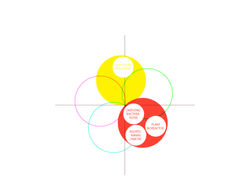 |
|---|
 |
 |
 |
|---|
 |
SUNTEK LAB

Day Chahroudi, MIT & Corte Madera, California, 1974
CAN NEW MATERIALS CHANGE THE ENERGY PROFILE OF SUBURBAN HOMES?
Suntek Research Associates was developed by Day Chahroudi and a group of MIT students, during Chahroudi’s teaching residency at MIT as a physicist, chemist, engineer and architect. In 1976, Suntek moved to the Silicon Valley where, the company developed its first Low-E coating for glass funded by the U.S. Department of Energy. Suntek Lab also developed three new materials, the Heat Mirror, the Cloud Gel, and Thermocrete (Chahroudi, “Buildings as Organisms”), all of which were used in the “Bioshelter House,” a re-imagination of the suburban tract home with the implementation of Suntek’s “Climate Envelope/Bioshelter Treatment.” Suntek claimed that for the same construction cost, you could have a home with free heat, daylighting, food, fresh air, and water. The “Bioshelter House” was designed with a transparent roof placed over an excavated area, surrounded by a berm of earth, with the bedrooms and bathrooms arrayed in a semicircle against the burm for insulation. The roof over this part of the house was planned as a vegetable garden that would insulate the space.
Suntek planned to achieve their objective for the suburban home with the help of their material inventions at the Lab. The Heat Mirror provided both visible daylight and ‘as-needed’ insulation in a thin clear coating that allowed for optimal views. The coating was so thin that the glass appeared as visually transmissive as normal glass, while it had the same insulating properties of wool or plastic foam; it reflected long wave infrared heat, aiding a building in combination with a thermal mass design strategy (Chahroudi. “Buildings as Organisms”). The product’s advertisement in Science Digest featured a joyful woman behind an elusively translucent thin partition, which would modify its material state from transparent to opaque according to inner microclimates.
The second innovation involving heat and light that Suntek explored was Cloud Gel. Instead of reflecting heat and allowing light through, cloud gel became opaque with increased heat. With a temperature change of just three degrees, the material turned from translucent to opaque white. Once at the opaque stage, the coating reflected all light with no absorption, therefore no heat was transmitted into the building. When the temperature cooled again, the gel returnsed to its transparent state (Chahroudi. “Buildings as Organisms”). The range light transmittance in a space controlled by Cloud Gel could be between 90% and 30% (Smay, “Thinking Window Can Switch Off the Sun”).
Finally, thermocrete, was designed to act as a kind of super effective thermal mass. The idea was to create concrete blocks that obtain and store heat at a set temperature, and then to release it once the environment had cooled. An isothermal solution was put in place, making the system self-regulating. Every material contained a different melting point due to its composition and structure. Day Chahroudi envisioned both the Heat Mirror and the Cloud Gel to work together to perform a passive solar glazing strategy (Smay, “Thinking Window Can Switch Off the Sun”). These two material strategies would be the first two layers of the overall system. The third layer would be the Thermocrete. Ideally these three materials would work together to support a building throughout a year using only naturally available energy.
Suntek advertised the “heat mirror” as a transparent wonder of invisible insulation, with researchers John Brooks and Sandy Jones smiling behind the slim screen. In Stewart Brand’s book Soft-Tech, the product “Tuffak-Thinwall” was featured next to Charoudi’s article, with yet another jovial woman at the back of an interactive crystal screen. Thinwall was developed by the chemical manufacturing company Rohm & Haas in Philadelphia as an invention for transparent insulation. In both cases, the inventors explored the possibilities of design with biological substances and organic reactions that could be “semi-designed” at a molecular level. The underlying hypothesis was that it was possible to entirely dispose of hard mechanical devices and replace the controlled microenvironments with soft biologically tuned material structures.
KEYWORDS: Cloud Gel, Heat Mirror, Thermocrete, Low-emissivity
KEY FAILURES
LACK OF INVESTMENT: Due to the company’s small size and the unknown, unproven and risky notion of low-e technology at the time, Suntek was not successful in acquiring private-sector investment.
SHORT LIFESPAN: Cloud Gel’s life-span was relatively short only lasting 6 months before discoloration.
UNABLE TO MAINTAIN INTENDED TEMPERATURE: Thermocrete’s thermal evaluation failed by unsuccessfully maintaining the intended temperature. This could have occurred from the molding technique of this material. It was the wrong geometry for its intended purpose.
